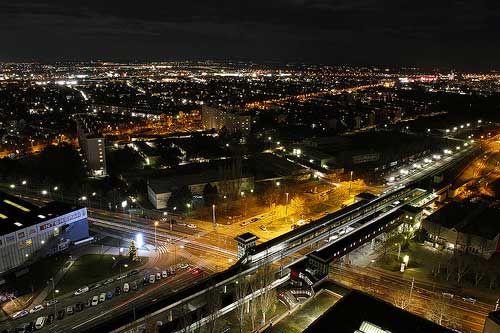Nicola Hodson
United Kingdom

I am observing the relentless commuter traffic in Cambridge during rush hour. Vehicles drive in, out, and around the city, efficiently delivering essential cargo to required locations. All this activity is crucial to the correct functioning of a major city, for without it everything would grind to a halt. I pull my chair back from the microscope in wonder, for what lies before me is not a city, but a single human cell.
As a cell biologist I am fascinated by this secret world hidden within a cell. From insects to humans, every single living creature consists of cells, yet as we go about our daily lives we do not give them much thought. How easy to forget that at all times every cell in your body is doing its bit to keep you alive.
A mere glance at a living cell down a microscope leaves one amazed. There is movement everywhere, not random, but highly controlled. Like any modern city, a cell has a highly developed transport network, and it uses it to obtain what it needs from the outside world and transport it inside.
Just like in a city, a cell needs certain things to keep going. In a city, gasoline needs to be delivered to the gas stations and food to supermarkets and households. Likewise, a cell needs to bring in essential nutrients, and just like the supermarkets and shoppers, it can select exactly what it wants delivering and when.
When a cell requires a particular substance from its environment, for example iron, it can send chauffeurs to its surface. We call these ‘receptors.’ They wait around patiently until their specific cargo drifts by. Once the receptors have collected their cargo, something fascinating happens. The cell surface at the location of the receptor begins to bend inwards, further and further, until it completely detaches, forming a bubble-shaped, cargo-containing vehicle. This vehicle is coated in an intriguing protein called clathrin, which is stiff and helps maintain a characteristic spherical shape.
Once inside the cell, these clathrin-coated vehicles need to deliver their cargo to the correct location. Considering how many different things a cell needs, a complex and highly developed infrastructure is required to organize it all. Consequently each cargo enters the cell stamped with a unique ‘sorting signal,’ not dissimilar to a postcode on a letter or a parcel. This allows cargo within the cell to be sorted in a way akin to what occurs at a mail sorting office and distributed to where it is needed by an efficient team of delivery proteins.
A whole host of different proteins are involved in the cargo-sorting process, from those that help the cell surface to bend inwards to ‘motor proteins’ that carry cargo-containing vehicles to remote locations in the cell. There are even roads and motorways for these proteins to travel on, we call these microtubules, and they allow the far-flung corners of the cell to be connected in the way we connect towns and cities by public transport and motorways.
Identifying new proteins involved in the cell’s transport network allows us to further understand how this complex cellular city functions. This is important because if the transport system in a cell fails, disaster quickly ensues. It only takes one protein, even one with a seemingly minor role, to acquire a mutation and the cargo does not get where it needs to go. Imagine if all supermarkets or petrol stations in a major city stopped receiving deliveries. The city would soon be in chaos.
Nerve cells illustrate the importance of the cells trafficking network. They are the longest cells in the body, some running all the way from the spinal cord to the big toe. If transport cannot occur from one end of these enormous cells to another, nervous impulses cannot be transmitted and one cannot to move properly. This results in a disease known as hereditary spastic paraplegia; people who suffer from this disease find that their lower limbs become increasingly stiff and they are unable to move.
To identify new proteins in the transport network, I remove proteins from the cell one by one, and look for cargo not arriving where it should. Much of the time when I get rid of a particular protein nothing happens, but sometimes all the cargo and receptors get stuck on the surface of the cell, and I know I have destroyed something involved in the delivery process, like a postman or a taxi company. Then I can put the defective cells under the microscope and start investigating the function of this mysterious protein more thoroughly, to find out exactly what it is and what role it plays.
Studying such a fundamental cellular process allows us to slowly, piece by piece, build up a picture of the cell’s interior. Nothing illustrates more the importance of the trafficking infrastructure of the cell than the fact that loss of many of the key proteins results in death before birth. So the more we learn, the more we can apply the knowledge to understanding human diseases.
Furthermore, a multitude of viruses and bacteria hijack the transport system of the cell in order to invade it and cause disease. These hijackers include the influenza virus and the AIDS-causing human immunodeficiency virus. Therefore if we can understand more about which proteins are involved in the cells trafficking, we can develop ways to effectively defend our cellular city.
NICOLA HODSON is a PhD student at the Cambridge Institute for Medical Research (CIMR). His PhD is in the area of cell biology and, in particular, how cells internalize what they need from their environment and transport it to the correct intracellular location. This research is fundamental to understanding diseases that are the result of cells being unable to transport what they need correctly. This includes hereditary spastic paraplegia (HSP) and learning difficulties.
Highlighted in Frontispiece Spring 2014 – Volume 6, Issue 2

Leave a Reply